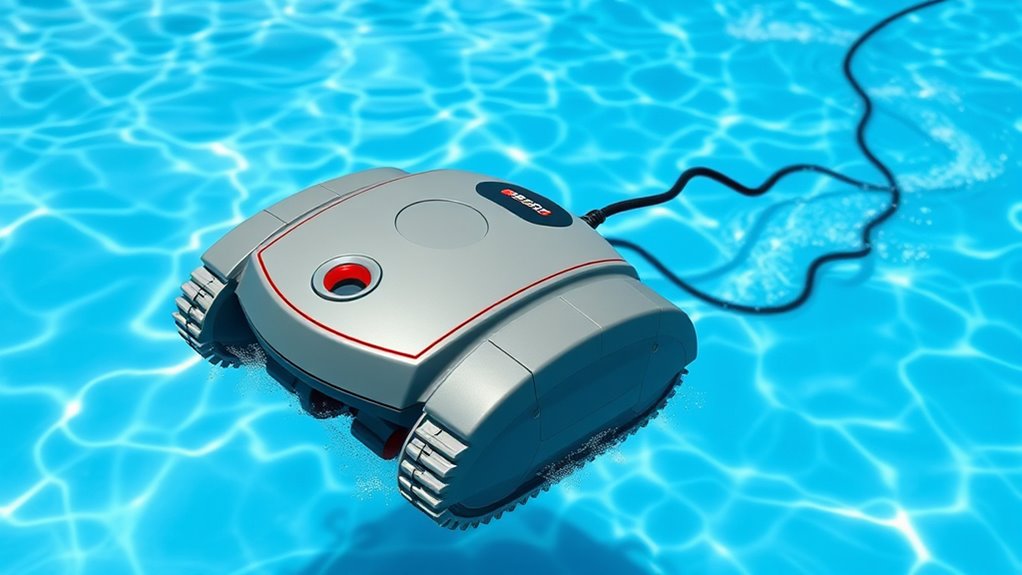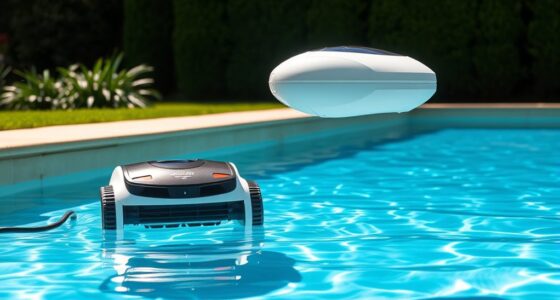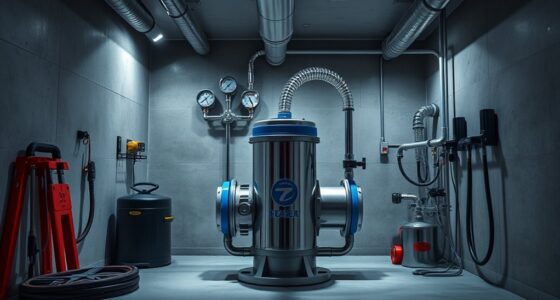Robotic pool cleaners work by autonomously steering your pool using sensors like ultrasonic, infrared, or water current detectors to avoid obstacles and cover the entire surface efficiently. They use motors, brushes, jets, and suction systems to loosen dirt, scrub algae, and collect debris in filters or collection chambers. Powered by rechargeable batteries, they optimize cleaning cycles with smart algorithms and water flow control. To discover more about how these smart devices keep your pool spotless, keep exploring.
Key Takeaways
- Robotic pool cleaners use motors to move, scrub surfaces, and collect debris through brushes and suction systems.
- Sensors detect obstacles and map the pool layout for efficient navigation and thorough coverage.
- Advanced algorithms optimize movement paths, avoiding overlaps and ensuring comprehensive cleaning.
- They rely on rechargeable batteries with power management features for extended operation and energy efficiency.
- Filters and debris chambers trap dirt, algae, and particles, maintaining water clarity during cleaning cycles.
The Basic Components of a Robotic Pool Cleaner
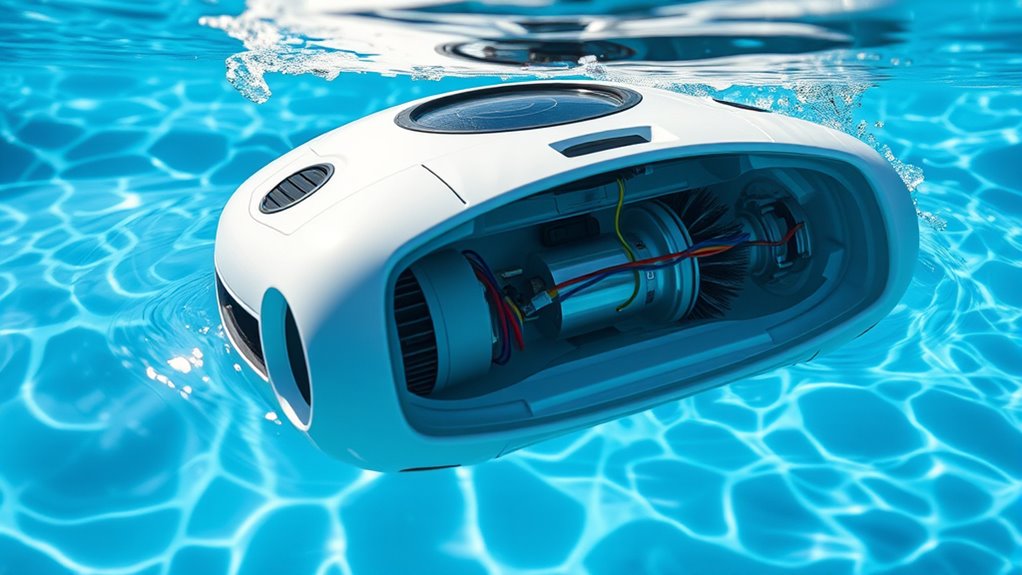
Have you ever wondered what makes a robotic pool cleaner work effectively? At its core, it relies on basic components like a motor, brushes, and a filtration system. The motor powers movement and scrubbing, while the brushes loosen dirt and debris. The filtration system traps particles, keeping your pool clean. While sensors aren’t the focus here, it’s important to note that water temperature and pool chemical levels influence cleaning efficiency. Warmer water can cause algae growth, making cleaning more challenging, and imbalanced chemicals can clog filters or damage components. The robot’s design ensures it navigates and cleans efficiently, but understanding these basic parts helps you grasp how it operates smoothly, maintaining your pool’s clarity regardless of water temperature or chemical balance. Additionally, filter replacement plays a vital role in sustaining optimal performance over time. Regular maintenance of internal components can further extend the robot’s lifespan and effectiveness, especially as automation technologies become more sophisticated.
How Sensors Enable Precise Navigation

Sensors help your robotic pool cleaner detect obstacles and avoid collisions efficiently. They also track the cleaner’s position, allowing it to plan the most effective path. By understanding obstacle detection techniques and path optimization strategies, you can guarantee your cleaner works smarter and faster. Additionally, integrating professional equipment ensures higher accuracy and durability in sensor performance. Knowing the local regulations can also help ensure your equipment complies with safety standards. Moreover, advancements in inspirational quotes about fatherhood demonstrate how innovative sensor technology can be inspired by nature and human ingenuity. Incorporating the Leather Bar Cart can also enhance the aesthetic appeal of your cleaning station, making maintenance more stylish and functional.
Obstacle Detection Techniques
Obstacle detection is essential for robotic pool cleaners to navigate efficiently and avoid collisions. Proper sensor calibration ensures accurate obstacle sensing, reducing false alarms and missed detections. You’ll find that obstacle avoidance strategies include various techniques such as:
- Ultrasonic sensors measuring distance to objects
- Infrared sensors detecting nearby obstacles
- Bump sensors triggering responses upon contact
- Laser sensors providing precise mapping
- Water current sensors aiding in movement adjustments
These sensors work together to give your cleaner a thorough understanding of its environment. By calibrating sensors correctly, your pool cleaner can respond immediately to obstacles, preventing damage and ensuring thorough cleaning. Proper organization and routine maintenance also contribute to the reliability of sensor functioning, ensuring consistent performance over time. Incorporating regular calibration into your maintenance routine can further enhance sensor accuracy and device safety. Additionally, understanding the importance of organization in maintaining your equipment can help prolong the lifespan of sensor components. This seamless integration of sensor technology enables your device to navigate complex pool layouts with confidence and precision.
Path Optimization Strategies
How do robotic pool cleaners achieve efficient coverage of complex pool surfaces? They use advanced sensors and algorithms to map out the pool’s layout, guaranteeing thorough cleaning without missing spots. Path optimization strategies help the cleaner avoid redundant routes, saving time and energy. This not only improves cleaning efficiency but also enhances pool safety by reducing the risk of the cleaner getting stuck or causing damage. A user interface makes it easy to select cleaning modes and monitor progress, giving you control over the process. Some models incorporate real-time sensors that adjust the cleaner’s path on the fly, adapting to obstacles or changes in pool shape. These strategies ensure your pool is cleaned effectively while providing a seamless, safe user experience.
Movement Algorithms and Path Planning
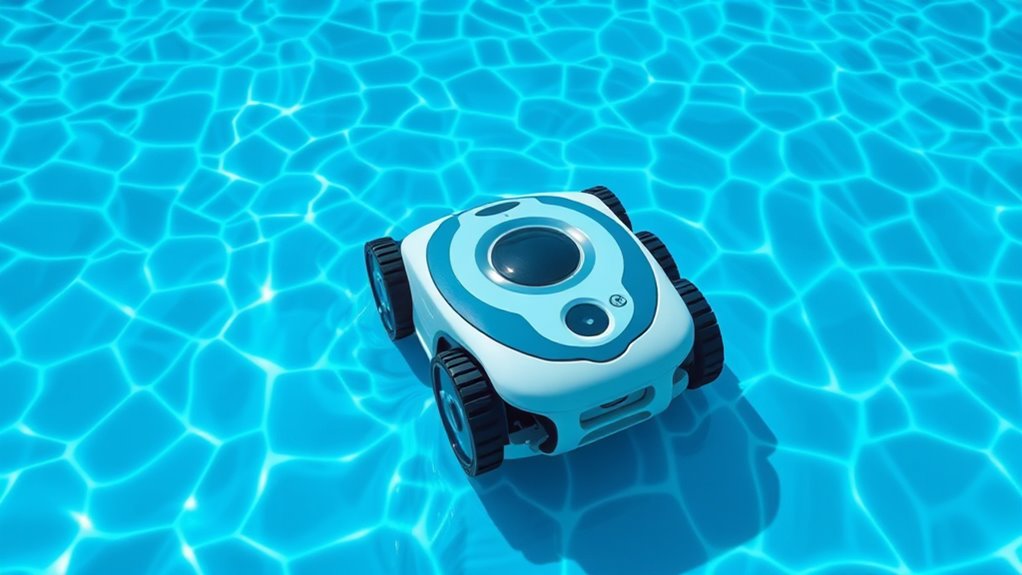
To guarantee thorough cleaning, robotic pool cleaners rely on sophisticated movement algorithms and path planning techniques. These systems ensure the cleaner covers every inch of your pool efficiently. They use sensor calibration to detect obstacles, walls, and water features, adjusting their path in real time. Regular software updates enhance navigation accuracy and optimize cleaning routes. Some key features include:
- Adaptive algorithms that learn your pool’s shape
- Random and systematic movement patterns
- Obstacle avoidance for seamless navigation
- Real-time sensor calibration for precision
- Updated software to improve path planning
- Predictive analytics can help optimize the cleaner’s operation by learning from past cleaning patterns and adjusting routes accordingly, leading to more efficient cleaning cycles. Additionally, incorporating sensor fusion techniques enhances obstacle detection and navigation reliability in complex pool environments. These advancements contribute to improved motion control, ensuring comprehensive coverage and energy efficiency. Moreover, understanding navigation algorithms helps in developing smarter cleaning strategies that adapt to unique pool layouts.
The Role of Brushes, Jets, and Suction Systems
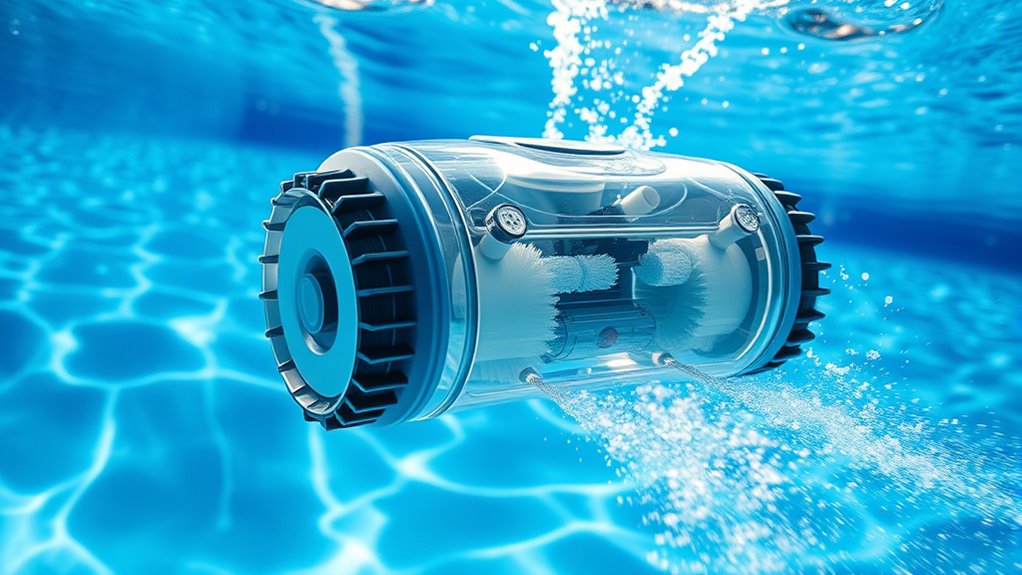
Brushes, jets, and suction systems work together to effectively remove debris and dirt from your pool’s surfaces. The brushes scrub algae, dirt, and pool chemical residues from the walls and floor, loosening stubborn buildup. Jets direct water flow, guiding debris toward the suction system. The powerful suction then pulls debris into the cleaner’s filter chamber, preventing clogs and ensuring continuous cleaning. Your robotic pool cleaner’s user interface allows you to select cleaning modes, monitor progress, and adjust settings based on your pool’s needs. This integrated system ensures thorough cleaning without manual effort, keeping your pool pristine and safe. Understanding how these components work together helps you optimize your cleaner’s performance and maintain a healthy, clear swimming environment.
Power Sources and Battery Management
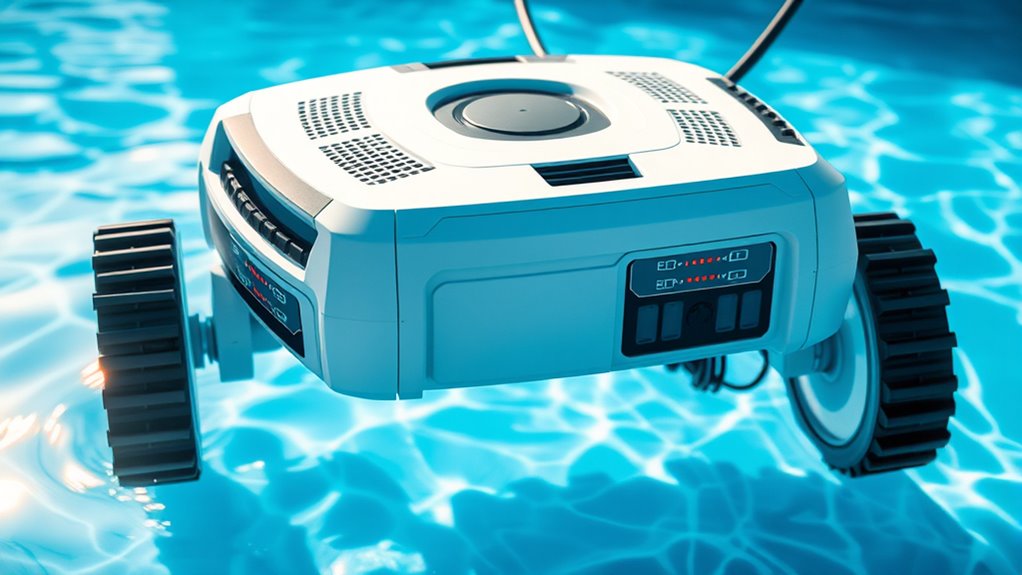
Robotic pool cleaners rely on their power sources to operate efficiently throughout their cleaning cycles. The type of battery or power supply compatibility determines how long your cleaner can work before needing a recharge. With better battery longevity, you get longer cleaning sessions and fewer interruptions. Modern models often feature rechargeable batteries that can be swapped easily, enhancing convenience. To maximize performance, consider these factors:
- Battery capacity and runtime
- Recharge time and cycle frequency
- Compatibility with different power sources
- Battery health management systems
- Indicators for low battery and charging status
An understanding of battery maintenance can help extend the overall lifespan of your robotic cleaner. Choosing a cleaner with reliable battery management systems ensures consistent performance and a longer lifespan. Efficient power sources help your robotic cleaner clean thoroughly without frequent recharges, saving you time and effort, especially when paired with power source compatibility. Additionally, selecting models with advanced power management features can optimize energy use and prolong battery life. Incorporating proper charging practices can further enhance battery performance and longevity.
Water Filtration and Debris Collection Mechanisms
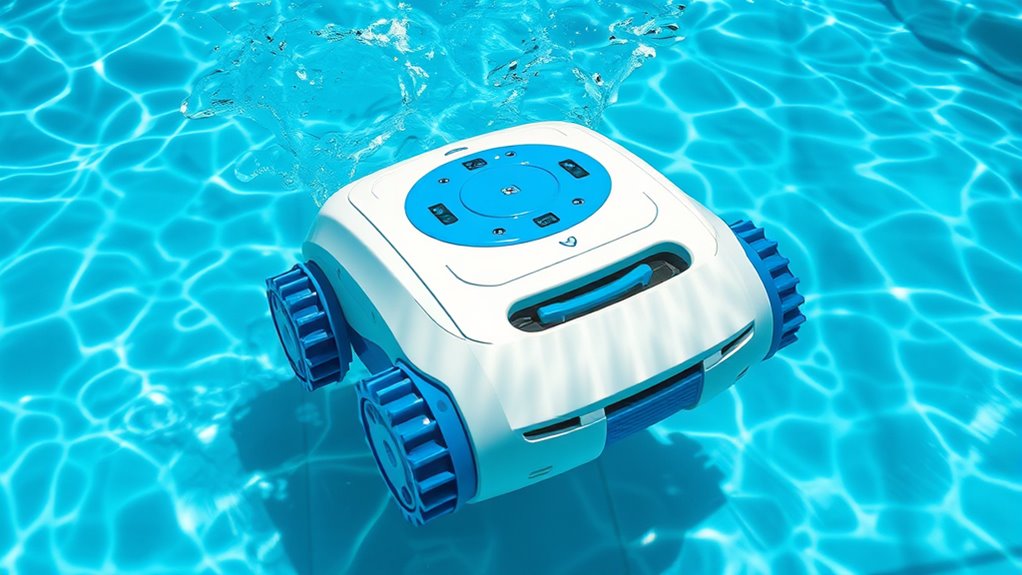
Ever wondered how robotic pool cleaners keep your pool spotless? It all comes down to their water filtration and debris collection mechanisms. As they move, these cleaners use powerful filters to trap dirt, leaves, insects, and algae, preventing clogging and maintaining proper water chemistry. Their fine mesh or cartridge filters capture particles small enough to preserve water clarity and balance. Some models include specialized debris chambers that make disposal simple. Additionally, these cleaners often work with your pool lighting, ensuring thorough cleaning even in darker corners. By continuously filtering water, they help keep the water chemistry stable, reducing the need for chemical adjustments. Proper maintenance of these filter systems is essential for optimal performance. This efficient debris collection keeps your pool inviting, clean, and ready for swimming at any time.
Advantages and Limitations of Robotic Pool Cleaners
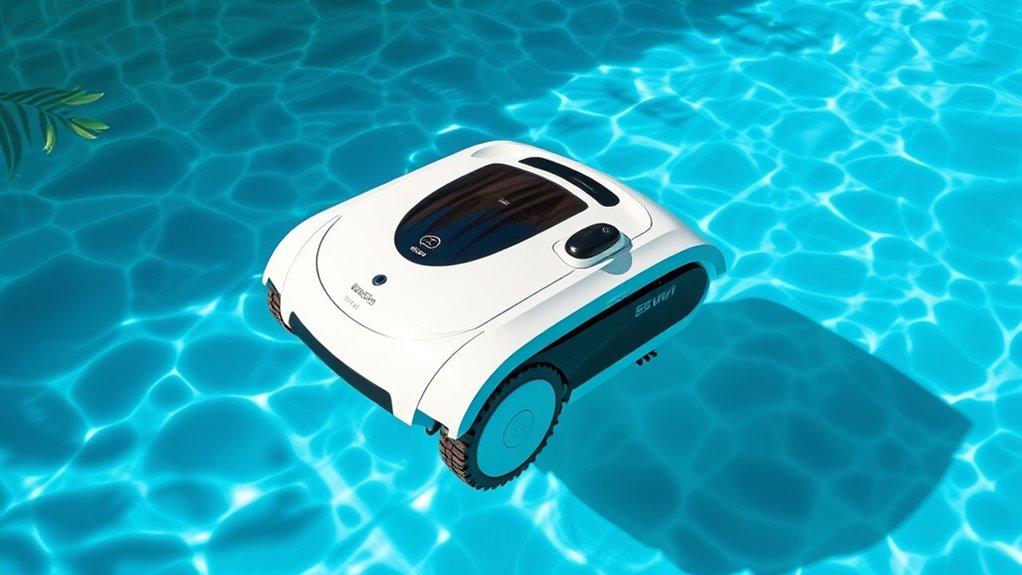
Robotic pool cleaners offer impressive efficiency and coverage, making pool maintenance easier for you. However, they can be costly to buy and maintain over time. Understanding these advantages and limitations helps you decide if they’re the right choice for your pool. Additionally, advancements in technology continue to enhance their creative potential, enabling more sophisticated features and better performance.
Efficiency and Coverage
Have you ever wondered how efficiently robotic pool cleaners can cover every inch of your pool? Their effectiveness depends on factors like pool size and user interface. Generally, these cleaners excel at thoroughly scrubbing pools within their specified range, but larger pools may require more time or multiple runs. The user interface influences ease of programming and operation, directly affecting coverage.
Consider these points:
- Larger pools might need more cleaning cycles
- Advanced user interfaces simplify setup
- Some models have smart navigation for better coverage
- Coverage can vary based on pool shape
- Efficiency improves with proper maintenance
While they’re designed for exhaustive cleaning, coverage isn’t always perfect, especially in complex or oversized pools. Choosing the right model tailored to your pool size enhances efficiency.
Cost and Maintenance
Investing in a robotic pool cleaner can save you time and effort, but it also involves ongoing costs for maintenance and repairs. A thorough cost analysis helps you understand the initial investment and the expenses for replacing parts or batteries over time. While robotic cleaners are generally low-maintenance, regular maintenance tips like cleaning filters and checking for obstructions extend their lifespan. Keep in mind that some models may require professional repairs, adding to the overall cost. Although the upfront price might seem high, many users find that the convenience and efficiency outweigh the expenses. Staying on top of maintenance can prevent costly repairs and ensure your robotic cleaner continues to operate smoothly, making it a worthwhile investment in the long run.
Frequently Asked Questions
How Long Do Robotic Pool Cleaners Typically Operate on a Single Charge?
Your robotic pool cleaner typically runs for about 1.5 to 2 hours on a single charge. The battery life depends on the model and size of your pool, so it’s good to check your device’s specs. After cleaning, it usually needs a charging time of 2 to 4 hours. Make sure to keep an eye on the battery indicator to know when it’s time to recharge for the next cleaning session.
Can Robotic Pool Cleaners Clean Pools of All Shapes and Sizes?
You might wonder if robotic pool cleaners can handle all pool shapes and sizes. Generally, they’re designed to adapt well, but pool size and shape can affect cleaning efficiency. Larger or irregularly shaped pools may take longer to clean thoroughly, so choose a model suitable for your pool’s dimensions. Properly selecting a cleaner guarantees you get ideal results, no matter the pool’s shape or size.
How Do Robotic Cleaners Handle Complex Pool Obstructions or Stairs?
Imagine your robotic cleaner smoothly maneuvering a maze of obstacles and staircases, like a skilled explorer. It handles obstacle navigation with smart sensors that detect hazards and adjust course instantly. For stair climbing, advanced models have specialized wheels and algorithms that let them ascend and descend stairs safely. You’ll find your robotic pool cleaner efficiently tackling complex obstructions, ensuring every corner, step, and nook gets thoroughly cleaned without getting stuck or missing spots.
Are Robotic Pool Cleaners Effective in All Types of Pool Surfaces?
You might wonder if robotic pool cleaners work well on all surfaces. Their surface compatibility varies, but most are designed to handle common materials like tile, vinyl, and concrete. When choosing one, consider cleaning efficiency on your specific pool surface. A model suited for your pool type ensures peak debris removal and prevents damage, making your cleaning routine more effective and hassle-free.
What Maintenance Is Required to Keep Robotic Pool Cleaners Functioning Properly?
Imagine your robotic pool cleaner as the heartbeat of your pool’s cleanliness. To keep it running smoothly, you need to perform regular filter maintenance, ensuring debris doesn’t clog its system. Additionally, monitor the battery life and replace it when needed to prevent interruptions. With these simple steps, your cleaner will work like a champion, keeping your pool sparkling and inviting all season long.
Conclusion
Now that you know how robotic pool cleaners work, you can see they’re like tiny, tireless swimmers, steering your pool with precision. Their sensors, algorithms, and brushes work in harmony, making cleaning effortless for you. So, next time you see one gliding smoothly across the water, remember, it’s not just a machine—it’s a marvel of technology, turning pool cleaning from a chore into a silent symphony of innovation.
